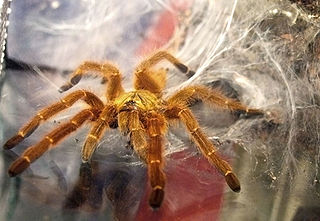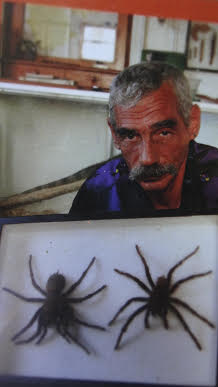
Barychelidae, also known as brushed trapdoor spiders, is a spider family with about 300 species in 39 genera.

The Harpactirinae are a subfamily of tarantulas which are native to the continent of Africa. Like many Old World tarantulas, they have a relatively strong venom and can inflict a painful bite.

Annandaliella travancorica is a species of tarantula spider found in the Western Ghats of India. It was the first of three members of the genus Annandaliella to be described, therefore the type species.

Ceratogyrus is a genus of tarantulas found in southern Africa. They are commonly called horned baboons for the foveal horn found on the peltidium in some species.

Selenocosmia is a genus of tarantulas that was first described by Anton Ausserer in 1871. The genus is found in China, New Guinea, Australia, Indonesia, Myanmar, Malaysia, Laos, Vietnam, Philippines, India and Pakistan. They are commonly referred to as whistling or barking spiders, due to their ability to stridulate using lyra hairs.

Annandaliella is a genus of tarantulas that was first described by A. S. Hirst in 1909. As of December 2019 it contains three species endemic to India: A. ernakulamensis, A. pectinifera, and A. travancorica. They are selenogyrid tarantulas, meaning they have a stridulating organ on the inner side of the chelicerae.

Psalmopoeus is a genus of the family Theraphosidae containing various species of tarantulas. The genus is native to Trinidad and Tobago, Colombia, Ecuador, Venezuela, Guyana, Brazil, Belize, Panama, Nicaragua, Costa Rica, Mexico, Guatemala and Honduras. All of these tarantulas are arboreal in nature, Psalmopoeus victori being the first arboreal tarantula of Mexico.

Tarantulas comprise a group of large and often hairy spiders of the family Theraphosidae. As of December 2023, 1,100 species have been identified, with 166 genera. The term "tarantula" is usually used to describe members of the family Theraphosidae, although many other members of the same infraorder (Mygalomorphae) are commonly referred to as "tarantulas" or "false tarantulas". Some of the more common species have become popular in the exotic pet trade. Many New World species kept as pets have setae known as urticating hairs that can cause irritation to the skin, and in extreme cases, cause damage to the eyes.

Theraphosa apophysis is a species of spider in the family Theraphosidae, found in Venezuela, Colombia and Brazil.

Cyriopagopus is a genus of southeast Asian tarantulas found from Myanmar to the Philippines. As of March 2017, the genus includes species formerly placed in Haplopelma. It was first described by Eugène Louis Simon in 1887.
Euphrictus spinosus is a tarantula, subfamily Selenogyrinae, first described by A.S. Hirst in 1908. It is only known from the male, and from the Dja River, Cameroon.
The Selenogyrinae are a subfamily of tarantulas found in Africa and Asia.
Euphrictus squamosus is a tarantula in the Selenogyrinae subfamily. It is native to the Congo.
Annandaliella ernakulamensis is a species of tarantula in the subfamily Selenogyrinae. It is one of three species in the genus Annandaliella and the first to be described in 73 years. It is native to Ernakulam, Kerala State, India.
Bacillochilus is a monotypic genus of African tarantulas containing the single species, Bacillochilus xenostridulans. The genus and sole species were both described by R. C. Gallon in 2010, and is found in Angola. The name is a combination of the Ancient Greek "xénos" (ξενος), meaning "foreign" or "strange", and the Latin "stridulere", meaning "to creak". It is a reference to the unusual form of the stridulatory organ that distinguishes it from other members of the subfamily Harpactirinae.
Selenogyrus is a genus of spider, or more specifically, selenogyrine theraphosid. The type species is Selenogyrus caeruleus.
Trichopelma zebra is a species of ischnocoline tarantula that is known from Panama.

Chilobrachys is a genus of Asian tarantulas that was first described by Ferdinand Anton Franz Karsch in 1892. They are found in India, Myanmar, Malaysia, China, Vietnam, Thailand and Sri Lanka. They are usually medium or large-sized, and they can stridulate by using small spines present on the chelicerae.

Phlogiellus is a genus of tarantulas that was first described by Reginald Innes Pocock in 1897. They are found throughout Asia and Papua New Guinea, including Indonesia, the Philippines, Papua New Guinea, China, Myanmar, Malaysia, Borneo, Thailand, the Solomon Islands and Taiwan. Phlogiellus is part Latin and part Greek, the first part being "φλóξ φλoγóϛ", meaning flame, the second part being "ellus" which is a latin diminutive suffix.
Selenogyrus caeruleus is a species of tarantula native to Sierra Leone.










